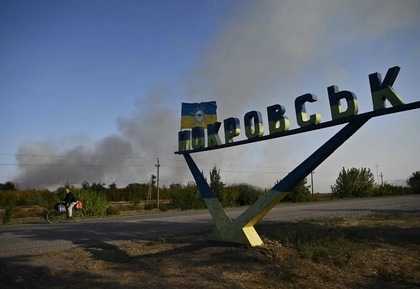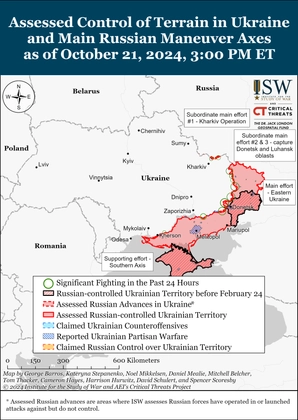More than 350,000 Ukrainian residents currently live under Russian occupation in Luhansk Region. Serhiy Haidai, the head of the Luhansk administration, told the Kyiv Post’s Aleksandra Klitina of the ongoing situation in the region and the successful attack by the Armed Forces of Ukraine on the headquarters of the Russian private military company Wagner in Popasna.
[Klitina] Good afternoon. The first question I wanted to ask is: do any settlements in Luhansk Region remain under the control of the Ukrainian army? Do Russian troops occupy the whole of Luhansk Region?
JOIN US ON TELEGRAM
Follow our coverage of the war on the @Kyivpost_official.
[Haidai] Yes, unfortunately, almost the entire region has been captured. The only constant battles are those taking place on the territory of two settlements. Sometimes, the control of a settlement can change several times a day, but the Russian army does not control all of Luhansk Region. The Ukrainian army is still holding firm.
[Klitina] Are these settlements located on the borders of the region?
[Haidai] Yes, they are on the border of Luhansk Region.
[Klitina] Can we say that Russian troops are using Luhansk Region as a springboard to capture Donetsk Region?
[Haidai] Yes, a bridgehead, but more for the regrouping of Russian troops, because over the course of four and a half months of heavy battles that continued in Luhansk Region, the Russians lost a lot of people and equipment.
The defense of Rubizhne, or the crossing in Bilohorivka, where the Russians lost a whole battalion of people and more than 100 pieces of equipment. This operation will go down in the history of this war. Now the Russian army needs to regroup, which is what they are doing. The main forces currently conducting an offensive on the Bakhmut front are the private military company Wagner (PMC Wagner).
[Klitina] Wagner’s headquarters were bombed in Popasna yesterday [August 14].
[Haidai] Let’s wait for official information from the General Staff, but I will not be surprised if we learn that more than 100 of Russia’s Wagner officers died there. Unfortunately, Prigozhin (head of the PMC Wagner) most likely escaped. He was present in certain photos of that place. Still, the effectiveness of this Ukrainian attack was very high.
[Klitina] Yes, it is a pity that Prigozhin survived because, according to investigations carried out by journalists, the Wagner PMC played a key role in the capture of Popasna. Prigozhin received the title the Hero of Russia after capturing Popasna. That would be symbolic.
[Haidai] The PMC Wagner is used by the Russian army to push through the Ukrainian defense line after prolonged shelling. Ramzan Kadyrov’s troops do not fight on the front line at all. They are not called Tik-Tok troops for a reason.
However, PWC Wagner is fighting on the front line. Earlier, it was some kind of elite-trained military personnel who served as special agents and went through more than one military campaign or war, but now they recruit prisoners from the Russian jail held by PWC Wagner.
The point is that there is no need to count them. Prisoners are not included in the official figures as dead Russian servicemen in Russia. No-one counts the number of dead and wounded either. The Wagner soldiers cannot abandon their duties if they are thrown into hell itself. They have one motivation – money.
[Klitina] How many people remain under Russian occupation in Luhansk Region?
[Haidai] I’ll split the region into several parts. In 2014, Luhansk Region had two million two hundred and fifty thousand people before the partial occupation of the territory by Russia. After 2014, 30% of Luhansk Region was occupied. This occupied 30% of the territory, including the largest cities, such as Alchevsk, Stakhanov, Luhansk, and 650,000 people still lived on the territory controlled by Ukraine, plus 200,000 were registered as internally displaced persons.
After February 24, when the full-scale Russian invasion of Ukraine began, the Ukrainian military had to leave some of the territory because the Russian army was attacking from all sides with a lot of equipment, and our military would not be able to hold such a huge, stretched defense line.
The fact that Ukrainian troops retreated to Kreminna and Rubizhne was a good thing, because it enabled the Ukrainian army to hold the defense line for five months. On the territories where the active phase of hostilities took place, cities like Kreminna, Rubizhne, Severodonetsk, Lysychansk, Zolote, and Popasna, the majority of the population left. More than 350,000 people remained in occupied territory of Luhansk Region.
[Klitina] 350,000 citizens are a lot. How are these people living in the occupied territories? Are there filtration camps there, just like there were in Mariupol? Is evacuation to Ukraine possible at the moment?
[Haidai] On the territory where the active phase of hostilities took place, people’s lives were extremely difficult because everything was destroyed – infrastructure, water supply, sewage, gas. In the territories left by the Ukrainian military, the situation is a little easier – there were no hostilities, so the infrastructure survived, but in the big cities: Rubizhne, Lysychansk, Severodonetsk – there is no way of ensuring the heating period.
[Klitina] Can these residents evacuate to the territory of Ukraine, or is it impossible?
[Haidai] There are three ways: the first is through Kharkiv Region – a walk across the dam. It is not a safe option because this area is under fire. The second option is through Zaporizhzhia. It is a long way because of control points manned by Russian troops. The third option is expensive, long, but probably the safest. Through Russia and other countries. There was a case when people came to Severodonetsk to pick up their things. They went from Ukraine to the Baltic States, Lithuania, then to Russia and Luhansk. This trip took two and a half days, and the tickets cost about 300 euros. Then another 10,000 hryvnias were paid to get from Luhansk to Severodonetsk and the same way back.
[Klitina] There were a lot of destruction in Luhansk Region. Did the Russian army destroy industrial and infrastructure facilities?
[Haidai] As for the infrastructure – gas supply, large main pipes were destroyed and burned to the ground. The water supply network in Popasna was bombed and blown up – one million residents were left without water. Electric sub-stations are broken, and the Russians are trying to restore them, but without success. Electricity is supplied to the cities directly without sub-stations. But without proper equipment it is 99 certain that the network will catch fire.
[Klitina] It’s no secret that many people in Luhansk Region supported Russia. For several months, the Russian army destroyed the entire region’s infrastructure, including residential quarters. Has the attitude of residents changed now?
[Haidai] Those narratives that Luhansk Region is all pro-Russian were debunked after the start of Russia’s full-scale aggression. In the cities of Novopskov, Starobilsk, Bilokurakino, and Svatovo, people went to peaceful demonstrations against the Russian invasion until the Russians began killing them. Russian soldiers shoot all those peaceful people with automatic weapons. Three were wounded, and residents stopped protesting after the invaders started shooting. I can understand them.
[Klitina] Do the majority of residents of Luhansk Region still support Ukraine?
[Haidai] Yes, especially in the territory that has not been occupied since 2014. Moreover, let’s count – Severodonetsk had a population of 120,000 citizens. About 10,000 remain now, as the rest have left. Lysychansk had a population of about 100,000, but around 15,000 remain. More than 300,000 residents of Luhansk Region left for Ukraine-controlled territory. It indicates that people did not want to live under Russian occupation.
Russia does not fulfill its promises of restoration, and the residents see it – the Russians absolutely refuse to restore Popasna. There is no centralized water supply. Instead of modern equipment and cars that should be part of housing and communal services, there is old equipment in the cities. A protest mood will be present among those remaining residents, which is a positive thing.
Also, it will be difficult to organize a quick referendum, which Russia is planning in Luhansk Region, and this is very important for Russians. Luhansk Region is the only one where they would like to hold a referendum. Because the majority of residents lived there in previously occupied territories and, therefore, it is possible to show a satisfactory result in percentage terms.
[Klitina] A partisan movement has appeared in Luhansk Region. There are numerous attacks on collaborators – will this trend increase in the future?
[Haidai] Of course, there will never be safety for collaborators. All collaborators will be under constant attack. Danger will always be present for them. I think that the Russians will have to look for new collaborators because the current ones will soon be liquidated.










